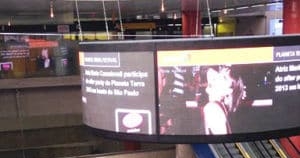When creating a display solution that optimizes immersion and engagement, it’s essential that the solution itself excludes any elements removing audiences from that digital world. Examples of such elements include dead pixels, discolored tiles, and glitches in content. What each of these troublesome malfunctions have in common is that they all represent an interruption. Bezels, too, are interruptions. These are the cross-hatch lines that segment LCD videowalls and though they are not a breakdown of technology, they are inherently an agent of fragmentation. So too are facets, the curved-display analogue of flat-surface bezels, and it is these facets that doom the immersive efforts of any not-truly-curved display attempting to pass itself off as curved.
Facets are to digital content what a screen door is to a porch; you can look outside through that screen door but that the porch remains outside beyond you is never in doubt. On a faceted display audiences can see the content but they can also see the facets, undercutting the level of immersion the content can achieve. Beyond this blow to immersion however it is less obvious what differentiates a faceted display from a truly curved one. There are a variety of design, manufacture, and performance related problems that arise when working with a faceted display solution so it’s important to buyers that these potential challenges be articulated. As the only manufacturer who creates a truly curved product, we at Nanolumens are uniquely positioned to explain.
Frame Skin Topology
The word “curved” is bandied about in the LED world as if every manufacturer creates a truly curved display but the fact of the matter is that none of them do. None, at least, except Nanolumens. Every other display company out there creates their “curves” by aligning flat, rigid displays next to one another at an angle. This leaves slight visible seams –the facets- between adjacent boards that are susceptible to contaminants. Nanolumens does things differently as the only manufacturer to use “frame-skin topology” in our curved display manufacturing, an outgrowth of our patented intellectual property on curved LED boards. This means that we build the frame of a display and then “skin” it with Nixels, our subcomponent boards. Our boards flex along our curved frames, eliminating the visible seams between rigid boards and more effectively locking out dust, debris, moisture, and other contaminants that can negatively affect performance.
Alignment Precision
This freeform design methodology allows for management of runout, which is the systematic buildup of gaps, overlaps, and misalignments that happen between adjacent modules as you build a display. The human eye is sensitive enough to perceive these inconsistencies even if they are small, but our frame-skin topology allows us to hit a tolerance ratio of 5% across the display. This essentially means that our flexible modules align so accurately that their margin of error is a distance measuring only 5% of pixel pitch, a minuscule ratio faceted curves can’t match –at least not enduringly. Though a faceted curve can hit low tolerance ratios during its installation, display imagery will degrade over each calibration until what you see on Day 365 hardly resembles what you paid for on Day 1. Working with facets makes it far more difficult to achieve this sort of engineering precision for the simple reason that there are more moving parts.
Too Many Variables
The more variables you add into a visualization solution, the more likely it is that something goes wrong. While our flexible LED boards can just wrap flush along the frame we build for them, other manufacturers must register each tile to the cabinet, a process that leaves gaps between cabinets that have to be managed to hide seams. This issue is often remedied with a third-party mount, which causes its own issues elsewhere, both mechanically and optically. Third-party mounts tend to intensify bright-lines and dark-lines while rendering the display solution more difficult to manage over time. These mounts also increase the time and cost of an installation and complicate logistics throughout the project.
Letting Content Do the Talking
Our goal at Nanolumens is to make the visual content shown on our displays do all of the talking. We’ve done it right when you only notice the immersive visual experience and not the display itself. That means no facets, no visible seams between modules, no module edges sticking out, no harsh angles between adjacent modules, no misalignments, and no color shifts between modules. Can a faceted curve make these same promises? If so, can they still make them a year down the road? If you’re interested in learning more about what separates a true seamless curve from a faceted substitute, contact us a call today!
Recommended:

